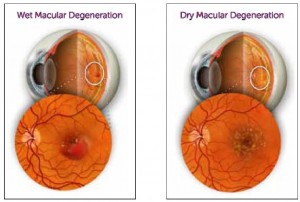
Age-related macular degeneration (AMD)
The image on the left shows bleeding at the macula due to wet AMD. The image on the right shows yellow deposits called drusen in dry AMD.
AMD is the most common cause of visual loss in adults in the developed world. AMD affects the macula, which is the most sensitive part of the retina. There are two forms of AMD: Wet and dry. Wet AMD occurs when abnormal blood vessels behind the retina start to grow under the macula. These new blood vessels tend to be very fragile and often leak blood and fluid. With wet AMD, loss of central vision can occur quickly. Dry AMD occurs when the light-sensitive cells in the macula slowly break down, gradually blurring central vision in the affected eye. As dry AMD gets worse, you may see a blurred spot in the center of your vision. Over time, as less of the macula functions, central vision is gradually lost in the affected eye. Patients with dry AMD are at higher risk of getting wet AMD.
Risk Factors for AMD
AMD affects mainly people aged older than 60 years. The major risk factors for developing AMD are: age, family history of AMD, and, smoking. There is a variant of AMD that affects mainly Asian people called Polypoidal Choroidal Vasculopathy (PCV). In PCV, there are usually no signs of dry AMD in either eye and the patient can get sudden loss of vision from sudden bleeding at the macula. AMD can cause sudden loss of vision if it is of the wet type. Dry AMD usually causes gradual loss of vision in both eyes. The symptoms of AMD include distortion of vision (straight objects looking wavy), and, loss of central vision (inability to recognize faces).
Tests for Macular Degeneration
AMD can be diagnosed by careful examination by an eye doctor. Retinal specialists may perform further tests like optical coherence tomography (OCT), fluorescein angiogram (FFA), or indocyanine green angiography (ICG). These tests can help determine the type of AMD and what treatment should be given.
anti-VEGF and Treatment for Wet Macular Degeneration
Wet AMD can be treated by various means. The most common type of treatment is intra-vitreal injection (injection into your eyeball) with drugs called anti-VEGF agents. VEGF is the main growth factor that causes AMD and there are several types of drugs available that can block VEGF, such as, Lucentis, Avastin, and VEGF-Trap-Eye (Eyelea). The main problem with these agents is that AMD patients require injections into the eye every one or two months for up to 1 year. Intra-vitreal injections are very safe and most patients do not experience any pain during the procedure which only lasts 10 seconds. For patients who have PCV, I often use Photodynamic laser therapy (PDT) in combination with an injection of anti-VEGF agent. PDT involves using a special drug called verteporfin being injected into your vein. This drug will collect in the abnormal blood vessels that are leaking at the macula and then will be activated by a special laser beam. The drug will cause the leaking blood vessels to close up and stop leaking. An ICG test before the PDT is crucial to identify these leaking blood vessels called polyps. Patients who have had PDT need to avoid direct exposure to sunlight for 2 days as verteporfin can make your skin sensitive to sunlight. For some patients who have very severe bleeding at the macula, I sometimes inject gas into the eyeball to try to displace the bleeding. Blood that stays in the macula is very toxic to the nerve cells and can cause permanent visual loss. The injection of gas can be combined with special drugs to dissolve the blood clot and anti-VEGF drugs. I sometimes also perform vitrectomy surgery if the bleeding has entered the vitreous cavity. Surgery allows more gas to be injected into the eyeball and allows some of the bleeding at the macula to be removed.
Dry AMD
For patients with dry AMD, there is good evidence that taking supplements high in anti-oxidants (Vitamin A, C, E, zinc) and carotenoids (beta carotene, lutein, zeaxanthin) may reduce the risk of developing wet AMD. A diet rich in omega-3 fatty acids (fish oil), and colourful vegetables and fruits, may also be beneficial.
Vitamins for AMD
Patients should consult an eye doctor before taking such high dose supplements. This will allow the eye doctor to tell them whether they have AMD and will benefit from taking supplements. These supplements can also interact with other drugs that the patient may be taking and should only be started after consulting their eye doctor. AMD should be treated by retinal specialists. There are some eye conditions that may appear like AMD such as, vitelliform maculopathy, but do not actually need to be treated. If you have unnecessary intra-vitreal injections, you are putting your eye at risk of getting an infection. Retinal specialists can also decide when should treatment be stopped. Very often, patients need eye injections every month for up to a year and it can be difficult to decide when to stop treatment or whether to change treatment to something else. Intra-vitreal injections also carry very small risks of retinal detachment, bleeding in the eye, and, infection. All these complications have to be managed by a retinal specialist. Any patient, aged above 60 years, with a family history of AMD should be examined once a year by an eye doctor to look for early signs of AMD. Dry AMD patients should also have annual eye examinations to look for wet AMD. Patients can also use home tests like the Amsler grid chart or the Preferential Hyperacuity Perimeter (PHP) to look for changes of Wet AMD. It can be very frightening to be diagnosed with AMD but the good news is that there are many choices now available to you in terms of prevention of progression of dry AMD and in treatment of Wet AMD.
You can listen to Dr Fong talking about prevention of AMD with diet. Here is a video of Dr Fong talking about AMD.
Cataract Surgery
What is a cataract?
A cataract is clouding of the lens in your eye. This is usually due to old age but can also occur due to trauma, diabetes, or due to medications.
Cataract surgery is done when the lens in your eye has become cloudy making it difficult for you to see well enough to carry out your usual daily activities. If the cataract is not removed, your vision may stay the same, but it will probably gradually get worse. Waiting for a longer period of time may make the operation more difficult. If you are considering surgery, please let the doctor know if you are taking the following medications: Flomax (Tamsulosin), Doxazosin, Asprin, or any blood thinning drugs like Warfarin, Plavix or Ticlid (Dipyradimole). These medications may need to be stopped before surgery.
You can listen to Dr Fong talking about cataract surgery.
Phacoemulsification surgery
The purpose of the operation is to replace the cataract with a plastic lens (implant) inside your eye. This usually done under local anesthesia. With a local anaesthetic you will be awake during the operation. You will not be able to see what is happening, but you will be aware of a bright light...
Read More

Recent articles on retinal diseases
Retinopathy of Prematurity
What is retinopathy of prematurity? Retinopathy of prematurity (ROP) occurs in infants who are born prematurely, where blood vessels in the retina do not form normally. The retina is a thin sheet ...
Latest news about nutritional supplements for AMD patients
Since 2006, eye doctors have been recommending a high dose of antioxidants and zinc for AMD patients to reduce their risk of getting advanced AMD (bleeding at the macula). The doses of Vitamin C, E, b...
Recovery after vitrectomy for epiretinal membrane
Epiretinal membrane is also known as macula pucker or cellophane maculopathy. Recovery after vitrectomy surgery to remove this fine scar tissue covering the macula can take up to 3 months. Surgery is ...
TV and radio interviews
- Bionic eye
- Dubious eye treatments and other current issues
- Dr Fong spoke at TEDx KL in Kuala Lumpur on 8 August 2015 to more than 5000 people about Myopia.
- Dr Fong interviewed live on TV about AMD and Food For Your Eyes
- Dr Fong is featured as a medical expert on Stan Lee’s Superhumans TV show
- What is AMD ? (in Mandarin)
- What is diabetic retinopathy? (in Mandarin)
- Best of eye advice in 2013
- Diabetic Eye Photos
- Systemic diseases and your eyes








